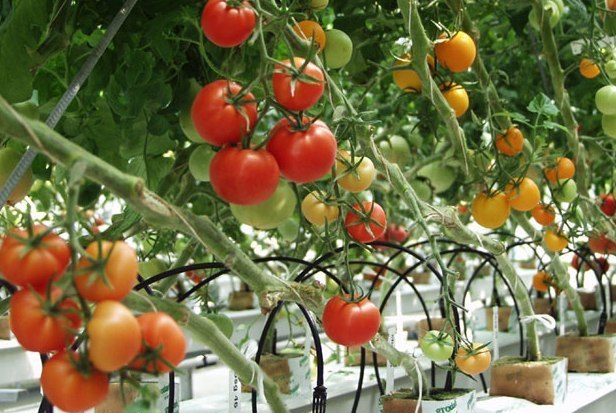Tomato commercial farming is beneficial farming in India. Peru, South America, is the origin city of tomatoes, but now, it is essential for commercial farming in India. Tomato is the second important crop in the world after the potato. The fruits can be eaten raw or cooked, and it provides vitamin A, C, minerals and potassium. We can make Soup, juice, ketchup and powder from tomatoes. Bihar, Karnataka, UP, Orissa, Maharashtra, Andhra Pradesh, MP and West Bengal are the primary producers of tomatoes. In addition, Amritsar, Ropar, Jalandhar, Hoshiarpur district are the major tomato producers in Punjab.
How to Do Tomato Commercial Farming?
We hope you have understood the value of Tomato commercial farming in India. So, let’s know how to do this farming step by step.
Climate Requirement
For tomato cultivation, the ideal temperature must be between 10-25°C. The rainfall must be from 400 to 600 mm for better yield production. During sowing, the temperature must be between 10-15°C. In addition, the harvesting temperature between 15-25°C is suitable for a better yield.
Soil Requirement
Tomato cultivation can be done in various soil types, from sandy loam to clay, red, and black soil with a good drainage system. Under well-drained sandy soil, it will give a high production or best results. For good results, you should treat the field with high organic content manure. Moreover, from 7 to 8.5 pH level of the soil is sound for tomato cultivation. Tomato is one of the crops, which can tolerate moderate acidic and saline soil. The light soil can give you the early crops, and for the heavy yield, silt-loam and clay loam soils are sound.
Popular Varieties of Tomato
Several varieties of tomato are available in India, which grows in different places, climate and rainfall conditions. We are here with some of them, which are:
- Punjab Ratta – 225 QTL/acre
- Punjab Chhuhara – 325 QTL/acre
- Keekruth Ageti
- Punjab Tropic – 90 to 95 QTL/acre
- Punjab Upma – 220 QTL/acre
- Keekruth
- Punjab NR -7 – 175 to 180 QTL/acre
- Punjab Red cherry – 430 to 440 QTL/acre
- Swarna Sampada Hybrid – 400 to 420 QTL/acre
- Punjab Varkha Bahar 2 – 215 QTL/acre
- Punjab Varkha Bahar 1 – 215 QTL/acre
- Swarna Baibhav Hybrid – 360 to 400 QTL/acre
- Punjab Swarna – 1087 QTL/acre
- Punjab Sona Cherry – 425 QTL/acre
- HS 102
- Punjab Kesari Cherry – 405 QTL/acre
- Punjab Kesar Cherry – 405 QTL/acre
- HS 101
- Punjab Varkha Bahar-4 – 245 QTL/acre
- Punjab Gaurav – 934 QTL/acre
- TH-1 – 245 QTL/acre
- Punjab Swarna – 1087 QTL/acre
- Punjab Sartaj – 898 QTL/acre, etc.
Land Preparation
Well, pulverise and levelled soil is perfect for tomato cultivation in India. You should plough the land four to five times to bring the soil to its fine tilth. In addition, you should buy or rent a good tractor like Solis tractor Price and others for this operation so that you can save more money. With the plough operation, you should plank the field after each plough to level the ground. Moreover, at the last ploughing, you should add the good value of organic manure like cow dung and others. In addition, you have to make soil raised bed for the plantation of tomatoes. 80-90cm width raised beds are suitable for the plantation. You can cover the beds with transparent plastic film to maximise the temperature and kill the pathogen.
Sowing
Tomato sowing operation starts in late November, and transplantation begins from the second fortnight of January for the spring season in northern states. On the other hand, sowing operation starts in August, and transplantation begins in August – September for the autumn crop. And in the hilly areas, sowing starts in March- April, and transplantation start in April -May. Apart from this, you should give space 60x30cm or 75x60cm or 75x75cm according to the growth habit, variety and uses. And for the rainy season, the space must be 120 -150 x 30cm. You should sow the seeds 4cm depth in the soil and cover them with the soil.
Irrigation
You should rinse the field with an interval of 6 to 7 days in winter and a 10 to 15 days interval in summer according to the soil moisture. Heavy watering can crack the fruits, and the flowers can drop. According to the research, the half-inch irrigation every fortnight can maximise the penetration of roots and give a high yield.
Harvesting
After 70 days from the plantation, the plants start to yield. And the harvesting operations depends upon the use like for fresh market product, for long time use or export, etc. So, you should harvest when 1/4th fruits portion gives pink colour for the transportation or long-distance market. When fruits are wholly red or pink, you should harvest them for the local market.
This was detailed information regarding commercial tomato farming in India. For more details, stay tuned with us.

